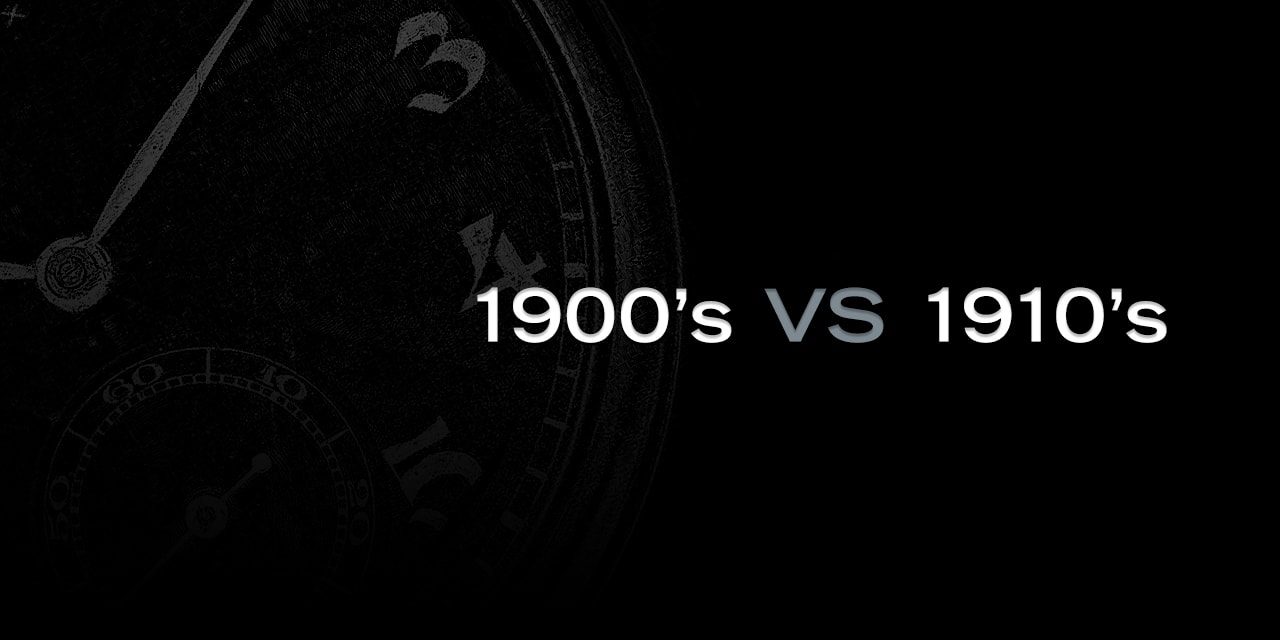Rolex of the 1900s versus the Rolex of the 1910s
For the final round of articles in our ‘Decades’ series, we’re going to take a bigger picture view.
Instead of concentrating on how a single watch model was transformed between one era to the next, we’re instead going to focus on the brand as a whole.
Rolex has been around, in one form or another, for well over a century and can lay claim to some of horology’s most enduring and valuable innovations. However, as with all such concerns, its beginnings were relatively humble. In fact, it would take several years in the business before they were able to raise themselves above the rest of the industry’s players in any meaningful way.
Below we explore what the first decade of Rolex’s existence encompassed, and see how it influenced everything which followed.
Rolex of the 1900s versus the Rolex of the 1910s: Where it Started
The company that would go on to become Rolex was established on the 22nd June 1905, in London.
It was founded by two men; Bavarian-born Hans Eberhard Wilhelm Wilsdorf and his brother-in-law, Alfred Davis.
Wilsdorf had actually moved to London in 1903 as a 22-year old working as a clerk for a large watchmaking firm believed to be Baer, Bechmann. It was a continuation of the job he had been doing in Switzerland since the turn of the century for the watch exporting company, Cuno Korten.
That experience served Wilsdorf well and just two years later he was ready to set up his own concern, borrowing money from his brother and sister to do so. His solicitors, White, Leonard & Co. introduced him to a third investor, Alfred James Davis and the pair set up Wilsdorf & Davis at 83 Hatton Garden, London E.C. in the heart of the city’s jewelry quarter. The two men held equal stakes in the venture, although Davis was very much the sleeping partner and little is known about him beyond the fact that Wilsdorf married his sister, Florence Frances May Crotty, in 1908.
Ironically considering the brand now, but in its earliest form Wilsdorf & Davis was not a watchmaking company at all. Rather, they were far more a sales and marketing business, advertising their wares directly to the public, something which had never been done before. The watches themselves were produced by other manufacturers, and Wilsdorf would buy in and assemble the finest components from all over Europe, principally from Switzerland. So he would, for example, take a movement from Swiss firm Aegler (with whom he shared a fruitful relationship for generations), house it inside an English watchcase and fit it with a bracelet made by Gay Frères, the legendary accessory maker who also crafted bracelets for the likes of Patek Philippe andVacheron Constantin.
The finished product could then be sold to jewelers who would add their own brand name to the dial.
Rolex of the 1900s versus the Rolex of the 1910s: Loftier Ambitions
Testament to Wilsdorf’s marketing genius, which would continue to serve him well for the rest of his life, was the fact that his company became one of the most successful of its type in just a few short years.
However, that was not enough. Wilsdorf had two main ambitions—firstly, he wanted to achieve something no one in his position had ever managed; getting his own brand name on the dials of his watches. And secondly, he wanted to popularize the wristwatch as opposed to the pocket watch as a timepiece for men. To that end, in the same year he founded Wilsdorf & Davis, he placed with Aegler thelargest order for wristwatch movements ever seen up until that point. He was attracted to the company’s products not only for their quality (they used the more accurate lever escapements rather than the cheaper cylinder type) but they were also small. These were perfect for the sorts of watches he was sure he could convince gentlemen of the era to wear.
Rolex of the 1900s versus the Rolex of the 1910s: Rolex Becomes Rolex
One problem Wilsdorf felt he had to overcome to achieve his goal of getting his own branding on his models was the length of the name itself.
Even with the average pocket watch’s large surface area, ‘Wilsdorf & Davis’ took up a lot of room, so he set to thinking up an alternative.
In 1908 he hit on and registered the name Rolex. Contrary to popular belief, it is a word with no meaning, much the same as Kodak. It was merely something which rolled off the tongue easily, was short enough to fit on a dial, was simple to memorize and would be pronounced the same in any language.
Yet the company wouldn’t officially become Rolex until 1915 following the outbreak of WWI, when Wilsdorf or anything else sounding even remotely German was guaranteed a somewhat frosty reception in London.
Getting the name onto his products was a slow process however. To begin with, Wilsdorf only succeeded in persuading his retailers to include it on one out of every six models. That would steadily increase over the years, spurred on by the number of high profile breakthroughs the company was having.
The first of any real note came in 1910, when a wristwatch, powered by an Aegler ‘11-ligne Rebberg movement with lever escapement’ won a First Class Chronometer Certificate from the Bienne rating office in Switzerland. They followed that up in 1914 by winning the first Class A Chronometer Certificate from the U.K.’s Kew Observatory to be awarded to a wristwatch. A tiny 25mm lady’s model, another Aegler-built piece, it was described as a ‘Keyless Crystal 11-Ligne Bracelet Watch’. Every previous recipient of the prize had been a marine chronometer.
Rolex of the 1900s versus the Rolex of the 1910s: The War Years
The same year that saw Rolex win its Kew Observatory award also witnessed the start of WWI. Strangely, this had more effect on popularizing the wristwatch than anything even Wilsdorf’s marketing acumen could dream up.
Because it was the first conflict fought over large distances, the old line-of-sight methods of communication were useless and attacks had to be coordinated by radio. That meant commanders needed highly accurate timepieces to launch offences simultaneously and pocket watches soon proved themselves too cumbersome.
When word reached home of soldiers jerry-rigging their pocket watches by soldering wire loops top and bottom to hold a strap, several manufacturers, Rolex included, set themselves to making so-called Trench watches specifically for them. When the war ended in 1919, returning troops sporting these new types of wristwatch signaled that they were now acceptable accessories for even the toughest of men and it marked the beginning of the end for the pocket watch.
Unfortunately, that was also the year the British government levied a 33% tax on luxury goods entering the country to help pay for the war effort. The move forced Rolex to open new offices in Geneva to avoid it and meant leaving London for good. The brand has remained there ever since.
Rolex’s formative years set the stage for future developments, not least in the expertise Wilsdorf demonstrated in getting his products noticed and changing attitudes towards them.
That notoriety would only increase in subsequent decades, and we will cover the period between the 1920s and 1930s in another article.
Featured Photo Credit: BeckerTime’s Archive.






